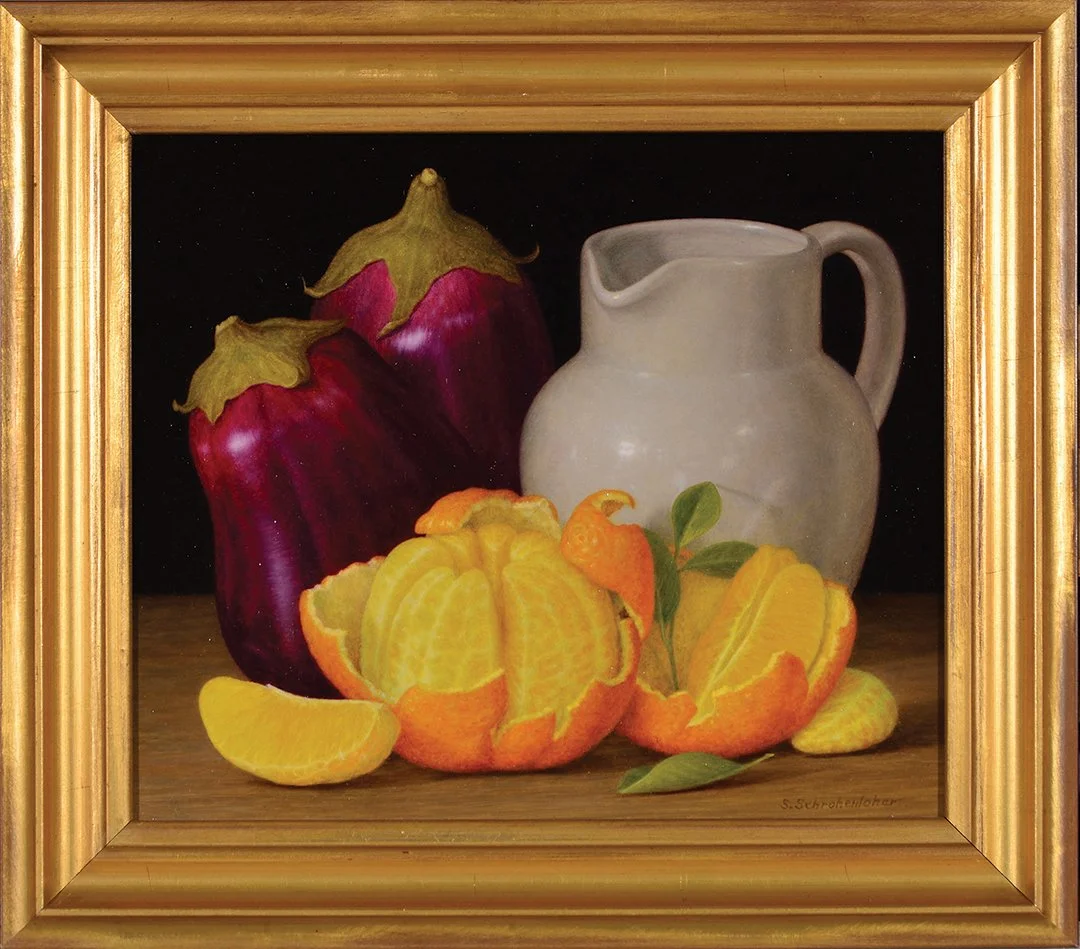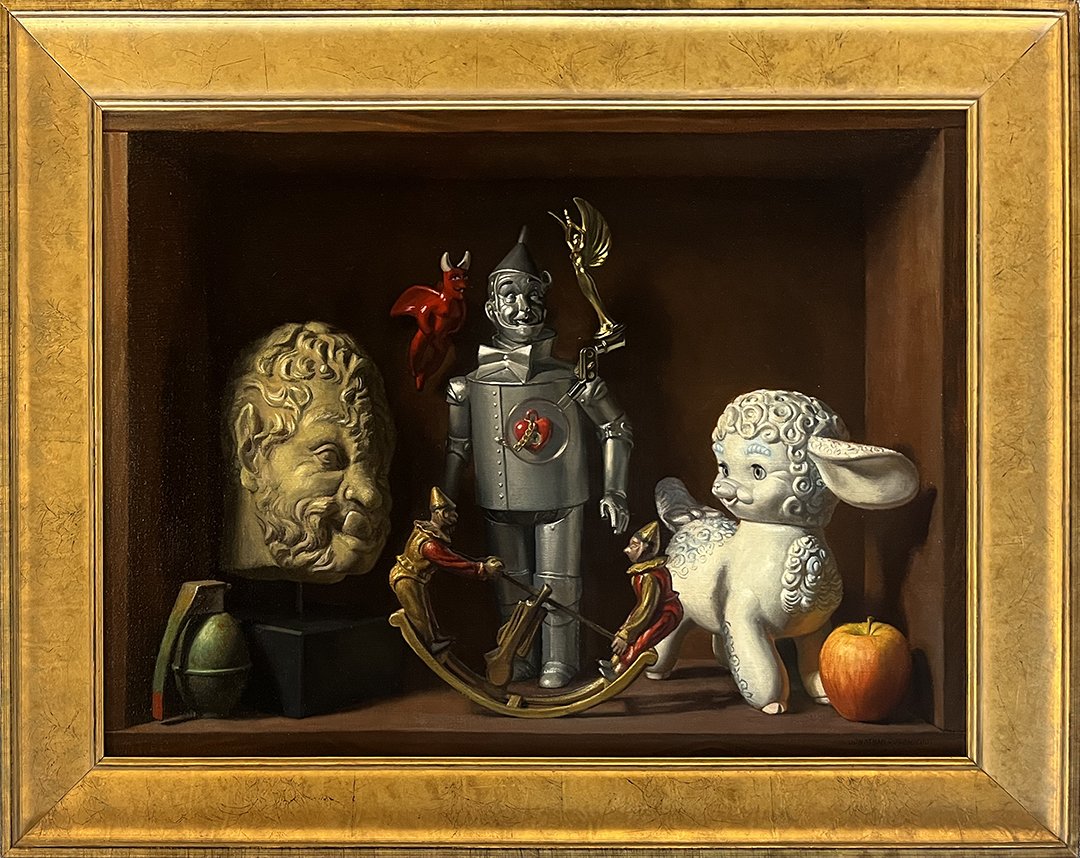Frederick Lester Sexton
Frederick Lester Sexton
Still Life
Oil on Canvas
16 x 27 inches
ID: Signed Lower Right DH2685
During his most active period in his career, the 1920s, 30s and 40s, he was widely reviewed and exhibited. His work was well received because it reflected the intimate vision of the desire of many people to turn away from national concerns to just living their lives in their home places. However, Sexton also saw a decline in his popularity with the advent of modernist movements such as Abstract Expressionism that began to dominate the American art world in the 1950s. Today, many artists including Sexton are being re-discovered as collectors and ordinary viewers learn once again that Realism is an acceptable part of American art because it speaks clearly and directly of the beauty they see around them.
Frederick Sexton was born in 1889 in Cheshire, Connecticut. His father, J. Frederick Sexton, was a prominent Episcopal clergyman and was Rector of St. Peter's Church in Cheshire. The mother, Mary Louise Lester, was from a fairly prominent Hartford family and was an amateur painter. When he was eighteen months old, Frederick was the victim of an open-hearth fire. Severely burned, his right hand was permanently closed. His mother died when he was nineteen, and the father held the family together.
Sexton attended public schools in New Haven and received art lessons from his mother. He attended the Yale School of Fine Art and studied with Augustus Tack and Sargent Kendall, and was given the coveted Winchester Prize for a year of study in Spain. He also won the John Weir Scholarship for self-study. Graduating in 1917, he was twenty-eight years old, which obviously was older than most of his peers in his class. However, he had worked many jobs in order to finance his education, including being a woodworking teacher in the New Haven public schools. He had fallen in love with his future wife, Dorothy Joyce, who shared his devotion to the Episcopalian Church.
During World War I, Sexton was an ambulance driver in France, and he earned commendation for his effective work. He did much traveling in Europe and was influenced by the many paintings he saw in museums and galleries including the modernist work of Cezanne.
His first recognition as an artist came in 1922 when one of his paintings was exhibited in the New Haven Paint and Clay Club. He was also asked to join the Club, becoming one of its early active members. He also became very active in the Old Lyme Art Colony at Old Lyme, Connecticut, and in the late 1920s began regular painting trips there. He associated with members of the Lyme Art Association but was prevented from becoming a member there because of the requirement in the Old Lyme Art Association membership rules of land ownership and of occupancy a certain number of weeks out of the year. Wanting to be a member, he bought land from Guy Wiggins, and in 1936 began to build a house and shortly after was voted into membership. Years later he became very angered when the rules were changed so that artists who lived within 25 miles were allowed to be members.
Sexton was also active as an organizer and exhibiter on the state level in the Connecticut Academy of Fine Arts, whose goal was to provide cooperation among all of the state's art associations. In New York, he was elected to the Salmagundi Club, but to his disappointment never achieved membership in the National Academy of Design.
He exhibited widely in New England, and was noted for paintings such as a portrait of his daughter, Dorothy, called "Dorothy and Her Cat"; his snow scenes and other landscapes; and religious themes such as "Nativity" and "Christ at the United Nations Assembled". In fact, he was one of the few artists of his era who painted religious subjects, something that for him was uniquely personal but also found a receptive audience.
His religious convictions were apparent in his personal life as he eschewed the Bohemian appearance that was increasingly popular among artists and did not approve of drinking alcoholic beverages, telling or laughing at off-color jokes, or using swear words. Generally he did not socialize but loved creative projects such as building his own boat and his three homes with his woodcarvings and hand-blown glass. Of these projects he said: . . ."a man needs something like that to keep him mentally alive." (14)
Frederick Sexton and his wife had one daughter, Dorothy who was born in 1923. She recalled her father as a very content man, who loved the self-reliance of his world of art, art books, poetry, visiting friends and working at his building projects. According to her, he was loving, kind and religious, and although he was not selfish, the household was dominated by his art career. She said he worried continually about money and being able to support the family but would never take anything that resembled charity. He was incensed by a gift subscription to "Gourmet" magazine and by someone who paid cash for a painting so he could avoid tax. He was highly protective of Dorothy---not letting her ride a bicycle nor be in the automobile of anyone else but her family's. She also said she hated being at Old Lyme because she was the only child there, and she had to spend her days with her mother in their unfinished house while he was off painting.
He also taught art classes in the New Haven and Branford schools and private schools including St. Margaret's in Waterbury and Hopkins Grammar. He taught his students that design in landscape reflected the design of God, theories that grew from his religious background. His commitment to traditional views on realism and theories of line, shape and color and the importance of easily understood narrative prevented him from accepting abstraction. He had difficulty with painting that seemed to express no love of nature or love of life itself. For him "Without a subject from God's world, design was an empty shell." (13)
As World War II approached, the peaceful world depicted and enjoyed by Frederick Sexton and his fellow artists disappeared as did much of the interest in their work, which now seemed outdated. Membership in The Lyme Art Association dwindled as did that of the Paint and Clay Club, and many of Sexton's artist friends were dying. However, his reputation remained fairly strong in the 1950s and 1960s, and in 1959 at the age of seventy, he took his wife to Europe to show her the places of his youth.
A very happy part of Sexton's later years was his friendship with Ira Hillyer, then living in New London, Connecticut. Hillyer was a young talented artist who exhibited occasionally at the Lyme Art Association. He took a special interest in Sexton's work and in 1964, commissioned him to paint portraits of himself and wife. The friendship lasted for eleven years until the death of Sexton. Dorothy Sexton recalled that "Fred loved to talk to Ira. Despite the difference in their ages, Ira understood painting and was one of the few people who was interested in religious art. Over the years Ira purchased nearly twenty painting from Sexton." He also held innumerable shows for him and "forwarded the money to the Sextons without any deductions. . . . Ira was for Sexton the Good Samaritan himself." (16)
In his last years, Sexton was very generous with his money, including putting his grandsons through school. On March 3,1975 Sexton died from a heart attack.
Memorial exhibitions were held at the Paint and Clay Club and The Lyme Art Association, but "indicative of the passing of an era", neither seemed well organized nor well attended. However, his wife of fifty-four years paid him a very loving tribute: "I am fortunate to have had him for fifty-four years and to be surrounded by the beautiful work he did." (17-18).
Source:
Helen K. Fusscas, "Frederick Sexton, 1889-1975", publication of The Connecticut Gallery, 1987.





